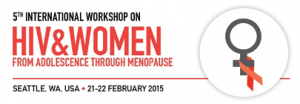Low prolactin and high 20alpha-HSD might contribute to ART-associated progesterone deficits in pregnancy
1 June 2015. Related: Conference reports, Antiretrovirals, Women's health, Pregnancy, Intl Workshop on HIV and Women 5th 2015.
A Canadian study presented at the 5th International Workshop on HIV & Women suggested that low progesterone (P4) levels observed in ART-exposed HIV positive pregnant women could be due to higher levels of 20alpha-hydroxysteroid dehydrogenase (20alpha-HSD) induced by low hPL levels.
ART has been linked to low birth weight, preterm delivery and other pregnancy complications. The study investigators had previously demonstrated that ART was associated with decreased levels of P4 mid-pregnancy in HIV positive women that correlated with birth weight.
For this study they investigated molecular mechanisms leading to ART-associated P4 level alterations in 33 HIV positive women receiving ART with 15 HIV negative women as controls.
The study assessed the expression levels of key enzymes of P4 synthesis and metabolism by PCR on placenta tissue. Plasma P4 and human prolactin (hPL) levels were quantified at week 33 to 37 of pregnancy by EIA. Human choriocarcinoma (BeWo) cells were treated with increasing doses of hPL for 24hours, 20alpha-HSD expression and P4 levels were measured by PCR and EIA respectively. P4 levels in ART-exposed BeWo cells were assessed with or without 20αHSD inhibition.
The investigators found P4 levels to be significantly lower in the HIV positive compared to the HIV negative group: median 131.0 (IQR 93.3-158.9) vs 171.1 (139.6-198.8) ng/mL respectively, p=0.014.
They noted that placental expression of most P4 metabolism enzymes was similar between groups. Only the P4-eliminating enzyme 20alpha-HSD was significantly higher in the HIV positive women: median 2.81 (IQR 0.89 to 26.05) vs 1.09 (0.623-1.56) arbitrary units in the HIV positive and HIV negative groups respectively, p=0.0084.
They found hPL, the main regulatory hormone for 20αHSD, to be significantly lower in the HIV positive group compared to controls: median 0.50 (IQR 0.38 to 0.72) vs 0.77 (0.48-0.89) ng/mL, respectively, p=0.043.
20αHSD expression significantly correlated with hPL levels in women’s plasma at week 33 to 37 of gestation, p<0.0001. In BeWo cells hPL down-regulated 20αHSD expression and P4 production – this was dose-dependent, p <0.0001. ART-exposed BeWo cells produced significantly less P4 compared to controls: median 2.8 (IQR 2.5 to 3.1) vs 3.6 (3.5 to 3.7) ng/mL, p=0.028. Inhibiting 20αHSD activity (3.6 [3.4-4.0] ng/mL) restored P4 levels.
The investigators concluded that low P4 levels observed in ART-exposed HIV positive pregnant women could be the result of higher levels of 20alpha-HSD induced by low hPL levels. And they suggested that this observation might help to identify potential new therapeutic targets that could improve birth outcomes for HIV positive pregnant women receiving ART.
Reference:
Papp E et al. Low prolactin and high 20alpha- HSD may contribute to cART-induced progesterone deficits in pregnancy. 5th International Workshop on HIV & Women, 21–22 February 2015, Seattle. Oral abstract O3.


